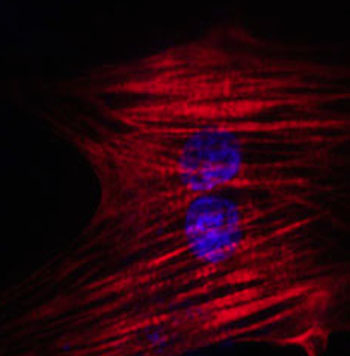Stem Cells Induced by Low Molecular Weight Compounds Transform into Working Heart and Brain Cells
By LabMedica International staff writers
Posted on 12 May 2016
A team of cell biologists has demonstrated the feasibility of using cocktails of low molecular weight compounds to induce skin cells to revert to a stem cell-like state that allowed them to be reprogrammed into cardiac or neural cells.Posted on 12 May 2016
Previous methods for transforming skin cells into induced pluripotent stem cells (IPSCs) and then into heart or brain cells required adding external genes to the cells. Investigators at the Gladstone Institutes (San Francisco, CA, USA) have overcome this requirement by demonstrating that combinations of nine compounds (9C and 9M) could be used to generate cardiomyocyte-like and neural stem cell-like cells from human and mouse fibroblasts.

Image: A human heart cell that was chemically reprogrammed from a human skin cell (Photo courtesy of Dr. Nan Cao, Gladstone Institutes).
They reported in the April 28, 2016, online edition of the journal Science that chemically induced cardiomyocyte-like cells (ciCMs) uniformly contracted and resembled human cardiomyocytes in their transcriptome, epigenetic, and electrophysiological properties. 9C treatment of human fibroblasts resulted in a more open-chromatin conformation at key heart developmental genes, enabling their promoters/enhancers to bind effectors of major cardiogenic signals. When transplanted into infarcted mouse hearts, 9C-treated fibroblasts were efficiently converted to ciCMs.
In a second paper published in the April 28, 2016, online edition of the journal Cell Stem Cell the investigators reported that neural stem cell-like cells (ciNSLCs) generated by using a cocktail of nine components (M9) closely resembled primary neural stem cells molecularly and functionally. Transcriptome analysis revealed that M9 induced a gradual and specific conversion of fibroblasts toward a neural fate. During reprogramming specific transcription factors such as Elk1 (ETS domain-containing protein Elk-1) and Gli2 (GLI family zinc finger 2) that are downstream of M9-induced signaling pathways bound and activated endogenous master neural genes to specify neural identity.
“This method brings us closer to being able to generate new cells at the site of injury in patients,” said senior author Sheng Ding, professor of pharmaceutical chemistry at the Gladstone Institutes. “Our hope is to one-day treat diseases like heart failure or Parkinson’s disease with drugs that help the heart and brain regenerate damaged areas from their own existing tissue cells. This process is much closer to the natural regeneration that happens in animals like newts and salamanders, which has long fascinated us.”
Related Links:
Gladstone Institutes














